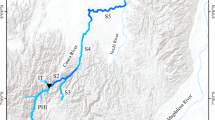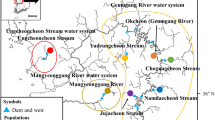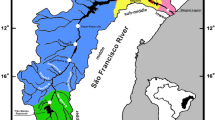Abstract
The freshwater fish curimba (Prochilodus argenteus) is an endemic species of the São Francisco River basin, with great aquaculture potential. The construction of several hydroelectric power dams along the river, and the pulsed releases of water from these dams altered and degraded the native fish habitats, which led to the development of a hatchery-reared fingerling restocking program. A comprehensive genetic baseline evaluation of the indigenous populations of curimba and of a hatchery stock was done using microsatellite markers. Pairwise F ST values, Bayesian analysis and the number of migrants per generation were used to illustrate the genetic structure of the curimba populations along almost 3000 km of the river, suggesting the existence of three units of conservation: one in the Upper, a second in the Middle and a third including part of the Middle, Submiddle and Lower stretches. We have analyzed the genetic contribution of hatchery stock releases in two stretches of the river using individual admixture coefficients; and the results showed that admixture makes a negligible contribution to indigenous recruitment. We discussed about supplementation programs for this river from the perspective of three units of conservation and the risks associated with using domesticated fish.




Similar content being viewed by others
References
Agência Nacional de Energia Elétrica (2005) http://www.aneel.gov.br. Brasília: Aneel. Acessado em Acessado em 14 de Agosto de 2015
Agostinho AA, Gomes LC, Pelicice FM (2007) Ecologia e manejo de recursos pesqueiros em reservatórios do Brasil. Eduem, Maringá, pp 23–25
Araki H, Schmid C (2010) Is hatchery stocking a help or harm? Evidence, limitations and future directions in ecological and genetic surveys. Aquaculture 308:2–11
Barroca T, Arantes F, Magalhaes B, Siqueira F, Horta C, Pena I, Dergam J, Kalapothakis E (2012) Genetic diversity and population structure of Prochilodus costatus and Prochilodus argenteus preceding dam construction in the Paraopeba River, São Francisco River Basin, Minas Gerais, Brazil. Open J Genet 2:121–130
Barton NH, Slatkin M (1986) A quasi-equilibrium theory of the distribution of rare alleles in a subdivided population. Heredity 56:409–415
Bednarek A (2001) Undamming rivers: a review of the ecological impacts of dam removal. Environ Manag 27:803–814
Campos Telles MP, Collevatti RG, da Costa MC, Barthem RB, da Silva Jr NJ, Souza-Neto AC, Diniz-Filho JAF (2011) A geographical genetics framework for inferring homing reproductive behavior in fishes. Genética 139:243–253
Christie MR, Ford MJ, Blouin MS (2014) On the reproductive success of early-generation hatchery fish in the wild. Evolut Appl 7:883–896
dos Santos JCE, Luz RK (2009) Effect of salinity and prey concentrations on Pseudoplatystoma corruscans, Prochilodus costatus and Lophiosilurus alexandri larviculture. Aquaculture 287:324–328
Evanno G, Regnault S, Goudet J (2005) Detecting the number of clusters of individuals using the software structure. A simulation study. Mol Ecol 14:2611–2620
Excoffier L, Laval G, Schneider S (2005) Arlequin ver. 3.0: An integrated software package for population genetics data analysis. Evolut Bioinform 1: 47–50
Falush D, Stephens M, Pritchard JK (2003) Inference of population structure using multilocus genotype data: linked loci and correlated allele frequencies. Genetics 164(4):1567–1587
Fearnside PM (2001) Environmental impacts of Brazil’s tucuruí dam: unlearned lessons for hydroelectric development in amazonia. Environ Manag 27:377–396
Frankham R (2008) Genetic adaptation to captivity in species conservation programs. Mol Ecol 17:325–333
Fraser DJ (2008) How well can captive breeding programs conserve biodiversity? A review of salmonids. Evol Appl 1(4):535–586
Godinho AL, Kynard B (2006) Migration and spawning of radio–tagged zulega (Prochilodus argenteus, Prochilodontidae) in a dammed Brazilian River. Trans Am Fish Soc 135:811–824
Godinho HP, Miranda MOT, Godinho AL, Santos JE (1997) Pesca e biologia do surubim Pseudoplatystoma coruscans no rio São Francisco. In: Miranda MOT (Org.) Surubim. Coleção Meio Ambiente, Série Estudos Pesca 19: 27–42
Godoy M P (1962) Marcação, migração e transplantação de peixes marcados na bacia do rio Paraná Superior. Arquivos do Museu Nacional 52:105–113
Gow JL, Tamkee P, Heggenes J, Wilson GA, Taylor EB (2011) Little impact of hatchery supplementation that uses native broodstock on the genetic structure and diversity of steelhead trout revealed by a large-scale spatio-temporal microsatellite survey. Evol Appl 4:763–782
Hansen MM, Nielsen EE, Bekkevold D, Mensberg K-L D (2001) Admixture analysis and stocking impact assessment in brown trout (Salmo trutta), estimated with incomplete baseline data. Can J Fish Aquat Sci 58:1853–1860
IEA—International Energy Agency (2015) Key World Energy Statistics https://www.iea.org/publications/. Accessed 21 Sept 2016
Jule KR, Leaver LA, Lea SEG (2008) The effects of captive experience on reintroduction survival in carnivores: a review and analysis. Biol Conserv 141:355–363
Kozfkay CC, Campbell MR, Heindel JA, Baker DJ, Kline P, Powell MS, Flagg TA (2008) A genetic evaluation of relatedness for broodstock management of captive, endangered Snake River sockeye salmon, Oncorhynchus nerka. Conserv Genet 9:1421–1430
Laikre L, Allendorf FW, Aroner LC, Baker CS, Gregovich DP, Hansen MM, Jackson JJ, Kendall KC, McKelvey K, Neel MC, Olivieri I, Ryman N, Schwartz MK, Short Bull R, Stetz JB, Tallmon DA, Taylor BL, Vojta CD, Waller DM, Waples RS (2010) Neglect of genetic diversity in implementation of the convention on biological diversity. Conserv Biol 24:86–88
Lima APS, Oliveira KK, Lima MA, Dantas HL, Maggioni R, Filho MA, Coimbra MRM (2012) Isolation and characterization of eight novel microsatellite markers in the Neotropical freshwater fish curimatã-pacu, Prochilodus argenteus (Agassiz, 1829). Mol Ecol Notes 13:341–343
Lopera-Barrero NM, Povh JA, Gualda T, Vargas L, Lopes TS, Boso K (2007) Monitoramento genético de estoques de curimba (Prochilodus lineatus) mantidos em ambientes controlados e destinados para programas de repovoamento. In: REUNIÃO ANUAL DA SOCIEDADE BRASILEIRA DE ZOOTECNIA: 44. Anais, Jaboticabal: UNESP, CD ROM
Lorenzen K, Beveridge M C M, Mangel M (2012) Cultured fish: integrative biology and management of domestication and interactions with wild fish. Biol Rev 87:639–660
Melo B F, Sato Y, Foresti F, Oliveira C (2013) The roles of marginal lagoons in the maintenance of genetic diversity in the Brazilian migratory fishes Prochilodus argenteus and P. costatus. Neotrop Ichthyol 11(3):625–636
Miller LM, Kapuscinski AR (2003) Genetic guidelines for hatchery supplementation programs. In: Hallerman EM (ed) Population genetics: principles and applications for fisheries scientists. American Fisheries Society, Bethesda, Maryland, pp 329–356
Oosterhout CV, Weetman D, Hutchinson WF (2006) Estimation and adjustment of microsatellite null alleles in nonequilibrium populations. Mol Ecol Notes 6:255–256
Ortega-Villaizan MdelM, Noguchi D, Taniguchi N (2011) Minimization of genetic diversity loss of endangered fish species captive broodstocks by means of minimal kinship selective crossbreeding. Aquaculture 318:239–243
Ostrensky A, Borghetti JR, Soto ED (2007) Estudo setorial para consolidação de uma aquicultura sustentável no Brasil. Grupo Integrado de Aquicultura e Estudos Ambientais, Curitiba, p 279
Peakall R, Smouse PE (2006) GenAlEx 6: Genetic Analysiz in Excel Population genetics software for teaching and research. Mol Ecol Notes 6:288–295
Piedras S R N, Pouey J L O, Moraes P R R (2006) Comportamento alimentar e reprodutivo de peixes exóticos e nativos cultivados na zona sul do Rio Grande do Sul. Revista Brasileira de Agrociência, Pelotas 12(3):341–344
Pritchard JK, Stephens P, Donnelly P (2000) Inference of population structure using multilocus genotype data. Genetics 155:945–959
Queller DC, Goodnight KF (1989) Estimating relatedness using genetic markers. Evolution 43:258–275
Raymond M, Rousset F (1995) GENEPOP (version 1.2): population genetics software for exact tests and ecumenicism. J Hered 86(3):248–249
Rice WR (1989) Analyzing tables of statistical tests. Evolution 43: 223–225
Sato Y (1999) Reprodução de peixes da bacia do rio São Francisco: indução e caracterização de padrões. Tese de Doutorado, Universidade Federal de São Carlos, p 179
Sato Y, Godinho HP (1999) Peixes da bacia do rio São Francisco. In: Lowe Mcconnell RH (ed) Estudos Ecológicos de Comunidades de Peixes Tropicais. EDUSP, São Paulo, pp 401–413 534pp
Sato Y, Sampaio E V (2005) A ictiofauna na região do alto São Francisco, com ênfase no reservatório de Três Marias, Minas Gerais. In: Nogueira MG, Henry R, Jorcin A (eds) Ecologia de reservatórios: impactos potenciais, ações de manejo e sistemas em cascata. Rima São Carlos pp 251–274
Sriphairoj K, Kamonrat W, Na-Nakorn U (2007) Genetic aspect in broodstock management of the critically endanger Mekong giant catfish, Panagasianodon gigas, in Thailand. Aquaculture 264:36–46
Stepien CA, Faber J (1998) Population genetic structure, phylogeography and spawning philopatry in walleye (Stizostedion vitreum) from mitochondrial DNA control region sequences. Mol Ecol 7:1752–1769
Wang JL (2011) COANCESTRY: a program for simulating, estimating and analysing relatedness and inbreeding coefficients. Mol Ecol Resour 11:141–145
Acknowledgements
This study was supported by a CTNI 92.2011.0520.00 grant from Companhia Hidro Elétrica do São Francisco (Chesf) and a scholarship provided by Coordenação de Aperfeiçoamento de Pessoal de Nível Superior (CAPES) to the second author. We are also grateful to Yoshimi Sato, José Cláudio Epaminondas, Charles Fabian, Kley Cunha and Álvaro Albuquerque, from CODEVASF, for their assistance in field collections. We also thank to anonymous reviewers who provided insightful comments on this manuscript.
Author information
Authors and Affiliations
Corresponding author
Electronic supplementary material
Below is the link to the electronic supplementary material.
Rights and permissions
About this article
Cite this article
Coimbra, M.R.M., Lima, A.P.S., Oliveira, K.K.C. et al. Microsatellite assessment of the genetic diversity in indigenous populations of curimba (Prochilodus argenteus) in the São Francisco river (Brazil). Conserv Genet 18, 965–975 (2017). https://doi.org/10.1007/s10592-017-0947-5
Received:
Accepted:
Published:
Issue Date:
DOI: https://doi.org/10.1007/s10592-017-0947-5




